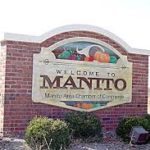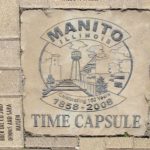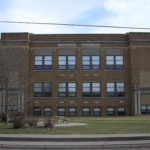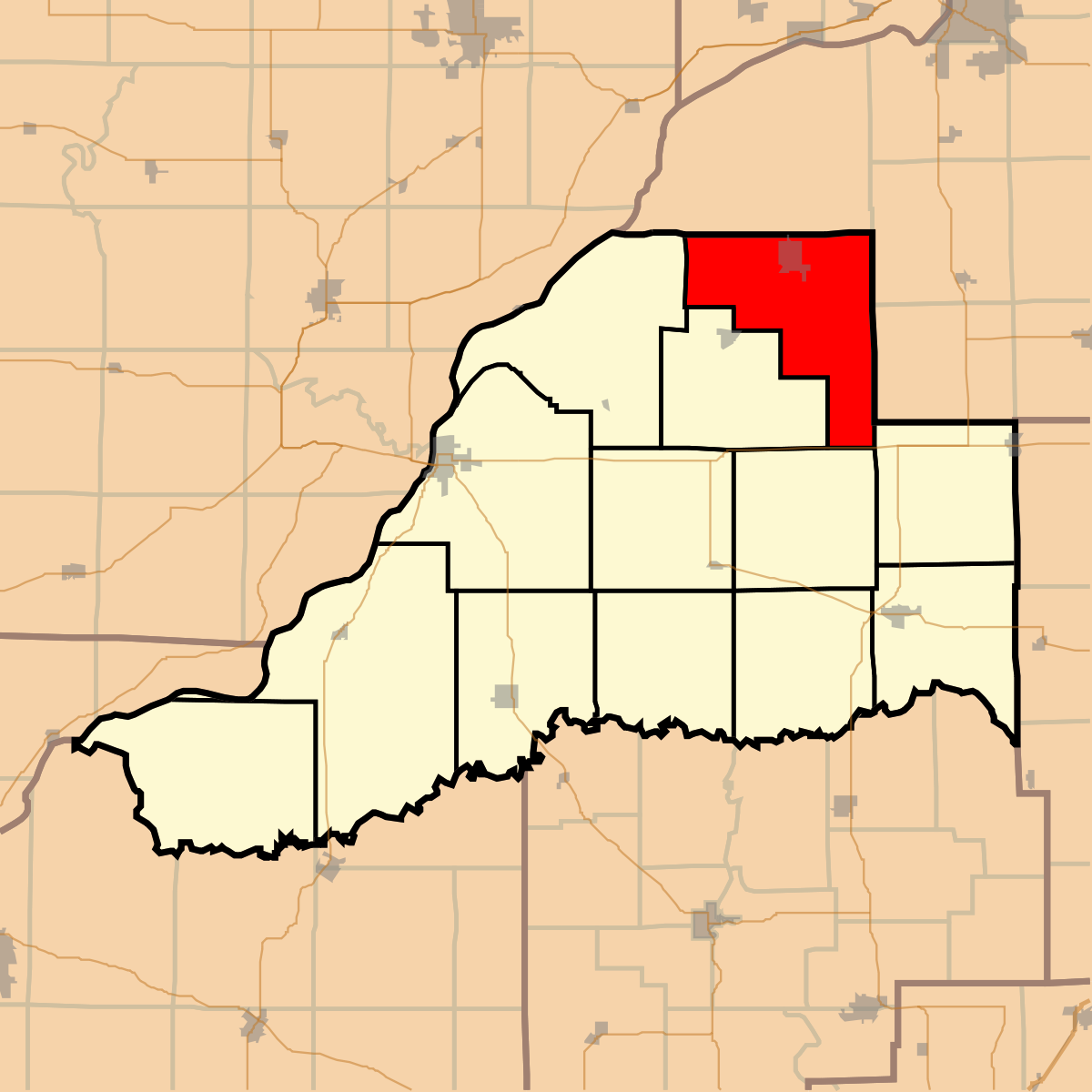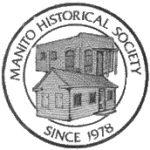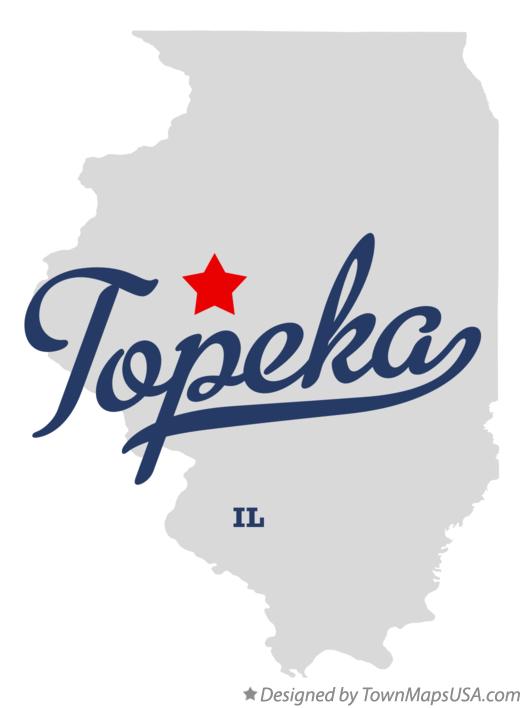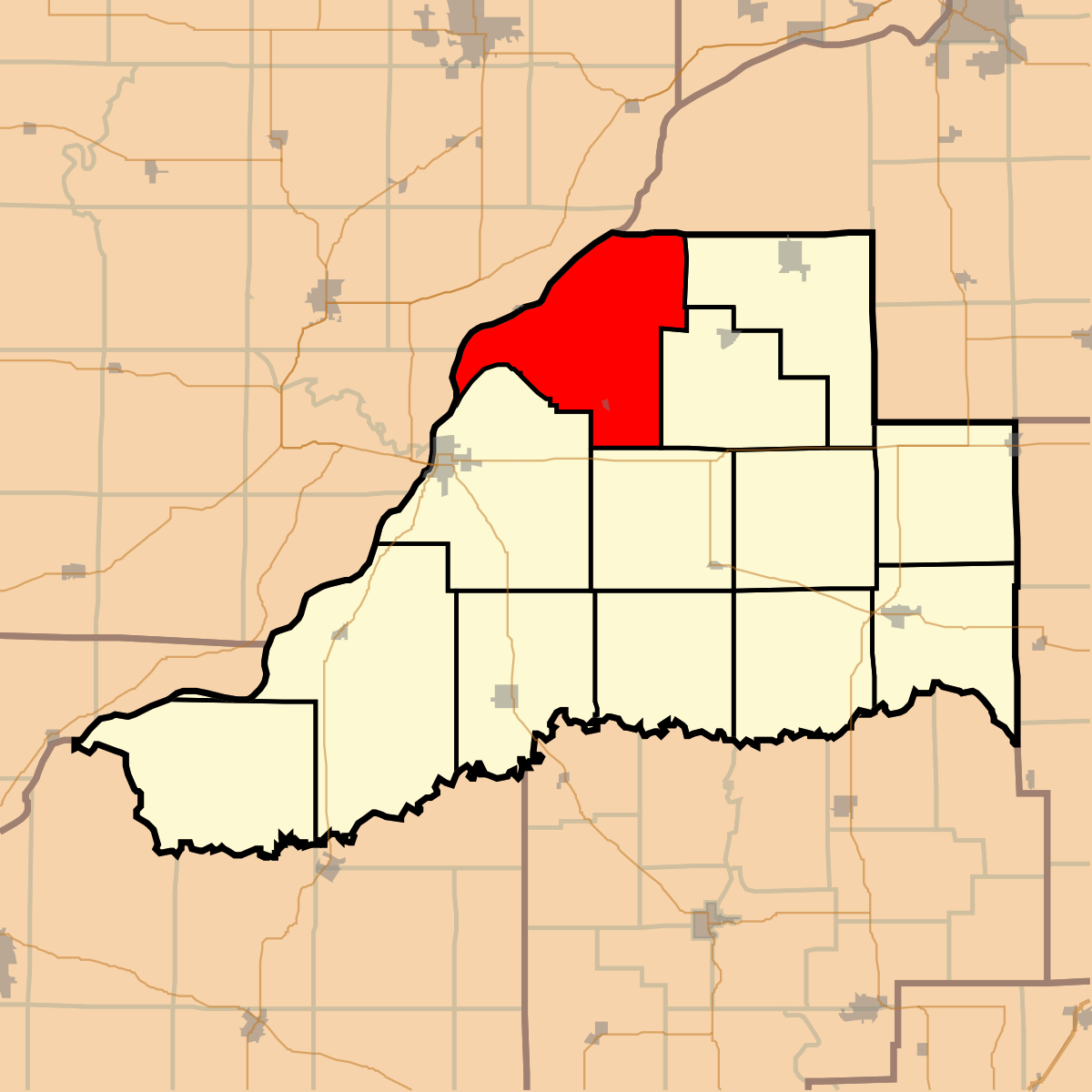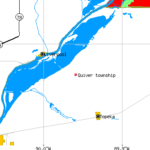QUIVER TOWNSHIP BIOGRAPHICAL SKETCHES
LORING AMES, farmer; P. O. Topeka; son of Zephaniah Ames, whose ancestors came over in the Mayflower during the reign of William and Mary. They were of English descent. His mother’s maiden name was Case. She was born in Connecticut, and was married to Mr. Ames in Maryland. In 1818, they came to Illinois, and settled on a farm in St. Clair Co. for a few years. They moved, in 1823, to Adams Co., where they both died he, in 1835, and she, in 1825. The subject of this sketch was born Sept. 13, 1806, and, when 1 year old, moved with his parents to Hemlock Forest, in Pennsylvania, and was there until 15 years old, when he came to Illinois with his parents. In 1827, he went to the lead mines in the West. During the time he was there, he participated in a war with the Indians, who were headed by Red Bud. He returned in 1829, and shortly afterward took a flatboat, starting from Quincy, and running to New Orleans. This was the first flatboat ever run down from Quincy, and was loaded with hogs, corn, potatoes, onions and oak staves. He returned in 1830, and worked on a farm for Gov. Wood, for two years. He had considerable management of Gov. Wood’s business, and was often called Governor by strangers. He next worked on a steam mill for Holmes; afterward, on a farm until 1832, when he was in the Black Hawk war. On his return, he began farming:, and continued it until married, which was in 1833, to Elmira Jones, daughter of Deacon Jones, who laid out Canton. In 1836, he moved to Fulton Co., and made brick in partnership with his father-in-law for one year ; he then farmed in Fulton Co. until 1856, when he came to Mason Co., and settled the present farm of 160 acres, which they obtained by their own labor. He became a member of the Congregational Church in Quincy, in 1831, and is now with the Methodist Episcopal Church, at Topeka, Il. His wife is also a member. The names of their children are Ardelia, Orpheus, who was in the war of the rebellion for three years ; Joel, also in the war ; George, Charles, Diantha and Emily.
S. ALLEN, farmer and teacher ; P. 0. Topeka ; son of Sylvanus Allen, who was born in Mason Co., Ky., Feb. 10, 1797, and moved to Ohio in 1804 ; was married Nov. 29, 1821, to Miss Bakehorn, daughter of George Bakehorn ; she was born April11, 1803, in New Jersey, and died Dec. 31, 1875. In the spring of 1830, they moved to Miami Co., Ohio, where they afterward resided. Mr. L. S. Allen was born Jan. 24, 1834, on a farm in Miami Co., Ohio ; at the age of 17, he began teaching, nd made his home with his parents until he was married, Aug. 27, 1865, to Mrs. Ella F. Davis, a daughter of Amos Flowers ; her husband, Mr. Davis, died in the late war. In 1864, Mr. Allen began merchandising at Lena, Ohio, in partnership with Mr. Brecount. In 1865, Mr. Brecount drew out, and Mr. Allen continued the business until 1867, when he came to Mason Co.,IL, and soon engaged in merchandising, at Topeka, in partnership with his brother-in-law, Mr. Flowers, and continued thus until about 1874, when they sold the business to Colviri & Hoagland. He then began teaching during the winters and farming in the summers, which he still continues. They have, by their frugality, secured themselves a house and lot in Topeka, and eighty acres of well- improved land near by. They have no children ; he has held the office of Town Clerk, and is at present a Notary Public ; he and his wife are members of the M. K. Church, at Topeka, in which ho has held the offices of Steward and Trustee, and is now KK Superintendent of the Sabbath school in that Church. He was once Justice of the Peace, and was also in the war, enlisting in the 147th Ohio V. I.
B. APPLEMAN, farmer; P. 0. Topeka; is the son of John and Catharine Appleman, both of New Jersey, the former of whom was born Oct. 7, 1800, came to Illinois about 1848, and was killed by a team running away, Sept. 28, 1866. He was a member of the Old School Presbyterian Church. His wife was born Oct. 26, 1800 ; her maiden name being Cross. Her confession was with the Reformed Church, but she afterward united with the Presbyterian, in which communion she died, April 6, 1872, a faithful Christian, sincerely devoted to the interests of the Church. They had a family of eleven children William C., born Dec. 4, 1821 ; Mary A., Jan. 2, 1824; Cornelia E., Jan. 27, 1826; Sarah L., May, 1828: Margaret A. (deceased), Nov. 18,1830; Alexander C., Jan. 22, 1833 ; Emeline, Sept. 22, 1835 ; Fannie C., Feb. 14, 1837 ; Augustus B., Nov. 1, 1838 ; John, March 14, 1841 ; Josephus M., Nov. 5, 1843. The subject of this sketch was born in Somerset Co., N. J., and when 9 years old came with the family, by team, as was customary in those days, to Mason Co., 111., and settled on thefarm which he now owns. It was then a raw prairie, but by their labors has become fine arable land. At 21, he rented of Mr. Anno for one year, afterward working on the farm of his brother-in-law, Mr. Cross. He then bought the present farm, the old homestead of his father, of 160 acres, and has since increased it to 280 acres. His marriage with Hannah C. McReynolds was celebrated Dec. 31, 1869, by Rev. Henr Decker, of the Reformed Church. Her father’s name was Robert McReynolds, who was born April 13, 1791, in Columbia Co., Penn. He was a farmer, Assessor and Judge.Her mother’s maiden name was Moyier. She was born Nov. 14, 1801, in Pennsylvania. They were both members of the Methodist Episcopal Church, in which communion they died. Mr. Appleman has been blessed with the following children Clara F., born in February, 1870 ; Clarence and Clayton, twins, Aug. 30, 1872 ; Frank M., Dec. 11, 1878., He has been and is now School Director, and was once Road Commissioner. His farm, which lies two miles northwest of Topeka, is one of the finest in the country. One could not be otherwise than happy, being thus surrounded by the fields and groves that lie adjacent to this residence. Yet Mr. Appleman has reasons for desiring to change localities.
CHARLES BARTELS, fanner and stock-dealer ; P. 0. Topeka ; son of Henry Bartels, a native of Germany, who came to America some thirty years ago , was a farmer and coal miner, and now makes a home with Mr. Bartels, whose mother’s name was Long, daughter of a noted farmer of Germany ; she came to America about thirty three years ago. The subject of this sketch was born Sept. 15, 1849, in Pottsville, Penn., where he remained until 21, at which time he came, with his parents, to Illinois, settling on the present farm of 160 acres, eighty of which now belong to him, the rest to a brother ; this is the old homestead of his father. Mr. Bartels has made good improvements and possesses a fine little home. His marriage with Anna Wills was celebrated Aug. 11, 1872 ; she is a daughter of William Wills, of Topeka, one of the noted men and early pioneers of the township, and one of the first settlers of Mason Co. ; she was born in 1854, in Mason Co., III. ; two children were the fruit of their marriage George H., born May 30, 1873; Lillie A., Aug. 7, 1876. Mr. Bartels has followed threshing and carpentering; he has been no office seeker, and has spent his past years in rural life.
THEODORE BELL, druggist and hardware, Topeka ; son of William Bell, who was born in Pennsylvania ; was a stonemason, and died in August, 1861; his wife’s maiden name was Hennigh, daughter of Daniel’ Hennigh, a noted farmer; she survived her husband and, two years after his death, came to Illinois, and is now making her home in Kansas, with her son Daniel. The subject of this sketch was born May 18, 1846, on a farm in Pennsylvania, and remained there engaged in going to school most of the time until 15 years old, when he left the scenes of his childhood soon after his last farewell to his father, and came, with his two sisters and one brother, to Mason Co., 111.; two years afterward, his mother came. Mr. Bell engaged, at his settlement, in farming for his older brother, Mr. Daniel Bell, with whom his mother makes her home in Kansas, and worked for him one season ; when nearly 18, he enlisted in Co. L, llth I. V. C., and served eighteen months; returning from war, he began working for his brother, on a farm, for one summer, and then engaged in clerking in a drug store for Harper & Robinson, of Havana, for six months; he then taught school for some time in Sherman Township. Mason Co., and afterward attended school at the Northwestern University at Plainfield,Il., for two terms; from there he went to Pennsylvania and engaged in reading law for a year with the firm of Longworth & Jenks ; afterward, he made a visit to Kansas and soon engaged in teaching school for three years, and, in 1875, he, like others who have left the beautiful plains of Mason Co., returned and engaged in teaching school for three years ; he then bought the drug store at Topeka, owned by C. H. Martz, to which he has added a hardware department,,nand in which business he still continues ; he has held the office of Town Clerk.
NATHAN CLARK, farmer ; P. 0. Petersburg ; is a native of Otsego Co., N. Y., where he was born May 9, 1818. There his boyhood and early life were spent, and, being of a musical turn, he studied music, and was for many years leader of a string band that became quite noted. He remembers furnishing music for Gen. Winfield Scott, and a number of other distinguished guests. He came to Illinois in 1863, locating in Mason Co. He now owns a fine tract of land. He removed to Petersburg in 1877, and renovated the Elmo House, and opened it as the Clark House. He married Elvira, daughter of Capt. Benedict, of Maryland, Sept. 2, 1845. They are parents of nine children, all of whom are now living and well educated, five being already teachers. Few can look back with more satisfaction over their past life than Mr. and Mrs. Clark. Mr. Clark was for a number of years passenger conductor on the P., P. & J. R. R. In 1879, Mr. Clark moved upon his farm in Quiver, where he now resides.
GEORGE D. COON, farmer and stock-dealer ; P. 0. Topeka ; son of Reuben and Anna Coon. The former was born on a farm in New Jersey, in 1787, and came to Illinois in 1842. His wife’s maiden name was Drake, daughter of George Drake, of New Jersey. She was born in 1793. They are both dead; he died in 1862, she in 1853. They were both members of the Baptist Church of New Jersey, and died in that faith. The subject of our sketch was born April 9, 1813, in New Brunswick,NJ., and remained there until 1839, and was engaged in farming and blacksmithing. In that year he came, by team, to Illinois, and settled in Greene Co., where he remained until 1842, at which time he moved to Mason Co., and settled on a farm for some time. He then settled on the present farm of eighty acres, which he had entered from the Government prior to his settlement on the same. He has given his attention entirely to agricultural pursuits, and has increased his land to 820 acres, and has improved the same. Seven hundred and twenty acres of this land is the fruit of their own labor and management. He celebrated his marriage, in 1836. with Harriet Brown, daughter of Stephen Brown, of New Jersey. He came to Illinois in 1849, with a family of seven children. His wife’s maiden name was Bishop. Mrs. Coon was born in 1815. Six children were the fruit of this happy marriage Mary J. (now Appleman), who has taught school, Waller L., Reuben G., Sophia B., George D. ; deceased, R. R. Mr. Coon retains a membership in the Baptist Church in New Jersey. At the time of Mr. Coon’s settlement the county was but little settled, and there yet remained now and then a wild animal which had perhaps narrowly escaped the flint-lock and spear of the savage. He has toiled on in rural life in the same channel with his neighbors, and has improved these raw prairies.
ALBERT CROSS, farmer and stock-dealer; P. O. Topeka; son of S. B. Cross, of Mason City Township ; his mother’s maiden name was McReynolds, daughter of a noted farmer of New Jersey; he was born Aug. 11, 1856, on a farm in Mason ‘Co.; 111., where he remained until 16 years old. at which time he moved with his parent* to Mason City Township, where they remained engaged in farming for four years. Mr. Cross, Sept. 20, 1876, was married to Fronia Slade, of Ohio, daughter of J. W. Slade ; her mother’s name was Van Gorden. a native of Ohio. After marriage they settled on his father’s farm in Mason City Township, and remained there some time, when they moved to the present farm of 160 acres, owned by J. W. Slade, which Mr. Cross controls, and on which he is having good success, having this season raised, wheat which averaged over twenty bushels per acre; this farm is finely improved. They have been blessed with one child Stephen R., born Nov. 23, 1878.
SARAH A. CADWALADER, boarding, Topeka; is a daughter of Isaac Wiseman, a farmer of Ohio ; he was born in 1776 in South Carolina, and died Dec. 31, 1833, in Hamilton, Ohio. Her mother’s maiden name was Harper, daughter of a farmer of Virginia; she was born in 1789 in Virginia, and died in 1856 in Ohio. The subject of this sketch was born in 1819 in Butler Co., Ohio ; when 14 years old, she went with the family to Hamilton, Ohio, where the family had gone for the benefit of part of them who were suffering with consumption, which disease ended the life of her father. In 1837, she was married to Hugh Beaty, a bricklayer and plasterer ; they settled at Hollow Springs for one year ; in the latter part of 1838, Mr. Beaty died, leaving her with an infant, which, shortly afterward, died also ; she then went to her mother’s home in Hamilton, Ohio, where she bore this sad bereavement. In 1842, she came with her mother and sister to Havana, 111., where she remained seven years. We here note a matter which shows a kind and sympathizing heart : This lady helped to make the shrouds and to lay out the bodies of eighty-five persons during a period of seven years. In 1849, she was married to Rees Cadwalader, a mechanic of Pennsylvania ; he was of a Quaker family, in which denomination he consecrated his all: he died in 1867. She, sometime afterward, bought and improved some property in Topeka, 111., where she now resides. By her last husband she had two children, both of whom died while infants. She is a strict member of the M. E. Church at Topeka, I11., in which communion she consecrated herself early in life.
JOHN G. DEVERMANN, farmer and stock-dealer, P. 0. Topeka; son of John Deverman, of Hanover, Germany, who died about 1862. Mr. Deverman’s mother’s maiden name was Hurkamp ; she was born in 1803 in Germany, and died May 8, 1879, at Mr. Deverman’s residence, in Quiver Township, where she had been living for some time ; she came to Illinois about 1863. Mr. Deverman was born Nov. 19, 1835, on a farm in Germany, and remained there until 22 years old, when he came to Illinois, settling in Havana for two months, and working for his brother-in law, at butchering; he next went to Matanzas, and engaged in farming for R. Havighorst, for one year, when he began farming, renting of George Beal for five years. He then, in 1864, married Anna Budke, of Germany, born in 1845 ; she came to Illinois, with her parents, in 1848 ; they were blessed with seven children Henry, Mary, Heoman, Willie, John, Lizzie and Katie (deceased). Mr, Deverman is now holding the office of School Director. He certainly felt decidedly the effects of poverty in his younger days ; on his arrival in this country he had but $15 ; this talent he improved, until now he has a farm of 225 acres, finely improved, the reward of his energy.
W. DOWNEY, physician and surgeon, Topeka; son of W. B. Downey, who was a native of Indiana, and is a farmer, now living in Allin Township, McLean Co., 111. His parents were English descent; his mother’s maiden name was Eaton, a daughter of John Eaton, of Indiana ; his father was also a farmer. Dr. Downey was born Nov. 4, 1851, near Martinsburg, Keokuk Co.. Iowa. At 41 years. he came with his parents, by team, as was customary in those days, to McLean Co., 111., and then engaged in farming and attending school. When 17 years of age, he began learning photography with Benjamin Gray, at Bloomington, 111. ; he continued this for one ye’ar, and then engaged to Gray and managed a gallery for him at Lincoln, Bloomington, and Fairbury ; while at the latter place, he bought this gallery from Gray, and moved it to Chatsworth, and there continued the business for six months In 1871, he quit photography, and returned to Allin Township, McLean Co., 111., where he attended school in the country. In 1872, he began teaching, which he continued, in connection with reading medicine, for over three years. In 1872, he attended one term at the Normal School, in McLean Co., Il; during the period he was teaching, he devoted every spare moment to the study of Latin and other branches congenial to his taste ; so earnest was he in the pursuit of the knowledge requisite to his future profession, that he studied on his way to and from school, and recited at night to John Q. Harris, who was Principal of the Stanford Schools. He has passed through many of the higher studies. In 1875-76, he attended the College of Physicians and Surgeons at Keokuk, Iowa, in which he graduated, and then engaged in practice with Dr. S. B. Wright, at Stanford. 111., for one year. In 1877, he came to Topeka, 111., where he has since practiced. He is an active and enthusiastic member of his profession, and enjoys an extensive practice. He has served a full share of those humble, but important public offices. He has twice been a member of the Board of Trustees of Stanford, 111., and was also a member of the Board of Trustees of the Public Library at the same place, of which he was one of the founders. He is’ now Police Magistrate of Topeka, and also Town Treasurer.
MOSES ECKARD, farmer ; P. O. Topeka ; son of Henry Eckard, of Baltimore, Md. ; was of German descent. His mother’s maiden name is Glass. She was from Maryland, and of German descent. They raised a family of four, two of whom survive Mr. Eckard and Elizabeth Morton. She is now living on the old homestead of her father. Mr. Eckard was born Oct. 8, 1812, in Fredericks Co., Md. He worked at farming. In 1837, he left the scene of his childhood for Ohio, where he worked at farming, carpentering, and such work as he could get to do. He afterward went to Kentucky, and there worked by the month at $12 until 1839, when he settled in Fulton Co , 111., for one year, and then worked for Jacob Moss for one year. He then came to Mason Co., and worked by the month for a long time. In 1844, he began farming eighty acres a part of the present farm of 500 acres, which was then raw prairie, but now has become fine arable land. By marriage he added 200 acres, making 700 acres. He was married to Sarah E. Simmonds Feb. 15, 1844. She was a daughter of Pollard Simmonds, who was born May 2, 1799, and was a farmer and miller. His father was born in 1773. His mother’s maiden name was Ritter. She was the daughter of Richard Ritter, of Maryland, born in 1763. Their marriage occurred Aug. 7, 1821, in Kentucky. Mrs. Eckard was born June 29, 1822, in Mason Co., Ky. She was the oldest of nine children, of whom but five survive Her father and mother are dead. He died Feb. 14, 1864, in Illinois, and she died May 10, 1855, in Illinois. They have had six children; the living are Sarah, W. H., station agent at Topeka, James P. and John R.
H. ECKARD, express and station agent and grain merchant, Topeka ; son of Moses Eckard, who was born in Maryland and a mechanic ; his mother’s maiden name was Simmons ; daughter of P. Simmons, of Kentucky; she was born in 1823, in Kentucky. The subject of this sketch was born .May 1, 1846, on a farm in Mason Co., 111., and remained there engaged in farming until 1867, when he engaged in merchandising at Topeka for a year, after which he engaged as station and express agent at Topeka ; also in buying grain for McFadden & Simmons, at this place, which he still continues. He was married, in 1868, to Amelia J. Bandean, daughter of John and Jane Bandean ; her father was drowned in a lock at Louisville, Ky., about the year 1846; her mother died in July, 1874. Mr. Eckard has held the office of Township Collector and Clerk, and is now School Director. He has frugally used his means, and has secured a nice house and lot in Topeka. Has three children Freddie R., Elmer^M. and Harry W.
W. FLOWERS, merchant, Topeka ; son of Amos and Phoebe Flowers ; was born in Pennsylvania ; the former was a merchant, physician and minister of the M. E. Church ; he died July 30, 1861, in Ohio ; the maiden name of the latter was Longstreth, daughter of Miller Lougstreth, a noted farmer ; she died Aug. 12,1874. They had eleven children, all of whom died in infancy except four. Mr. Flowers was born Juno 9, 1846, in Palestine, Darke Co., Ohio, and remained there until 6 years old, when the family moved to Miami Co., Ohio, where Mr. Flowers remained until 1866, when he came alone to Mason Co., and settled, teaching school at the Walker district, Mason Co., for one term ; he then came to Topeka and engaged as clerk in the dry-goods store of Eckard & Nichols for two years ; he then went into partnership with his brother-in-law, Mr. L. S. Allen, in dry-goods, under firm name of Allen & Flowers, and was thus connected six years. They then drew out, and the firm became Colvin & Hoagland. He then engaged in buying grain at Topeka for tVo years, for himself, after which he engaged in clerking for the firm of S. V. Brown (now Oliver Brown), which he still continues. His first marriage was in 1869, to Cassie Kelley, daughter of James Kelley, a farmer and stock-raiser; she died July 5, 1873, leaving two children Harry W. and Ellis C. In 1875, he was married to Mattie Curtis, daughter of Alfred Curtis, of Butler Co., Ohio. By this wife he also had two children Edna and Laura B. He has held the office of Town Trustee of Topeka, and Director of Schools, which he still holds, and has also been Town Clerk and Postmaster. He and wife are members of the M. E. Church of Topeka.
H. HUGHES, farmer and stock-dealer; P. 0. Topeka ; son of Harry Hughes, of Scotland, who was awhile in Pennsylvania a physician and overseer of iron-works. His wife was Hannah Penchion, daughter of John Penchion, of Ireland. She was born in Pennsylvania. He died about 1849, and his wife some time afterward came to Ohio, where she died in 1871. They were both strict church members. The subject of this sketch was born Oct. 5, 1841, on a farm in Franklin Co., Penn., and there remained till 21, when he enlisted in the 21st P. V. C., and served nearly two years; was a Corporal, and was wounded in the thigh at the battle of Bunker Hill, Va. On his return from the war, he engaged in teaching and teaming, in Noble Co., Ind., for about two years. In the spring of 1865, he left Indiana, with but little means, and came to Mason Co., 111inois., having on his arrival at Havana only $13.60 ; he engaged at work in a livery stable for Joseph Taylor, of Havana, for three months, when having saved his means, he engaged in partnership with Taylor, and was thus connected for three years, when Mr. Taylor drew out and the firm changed to Hughes & Banould, and continued such until : 869, when they sold to Taylor, and Mr. Hughes engaged in farming on 40 acres of land, near Mason City, which he owned ; he was also renting in addition ; he continued his farming at said place for two years, during which time he added 80 acres, and then traded his 120 acres for the present farm of 250 acres to which he has since added, until he now has 450 acres, which have been obtained entirely by his own labor, and which he has improved and made of fine quality, and well adapted to cattle raising, which he makes a specialty. Mr. Hughes was married, in 1867, to Georgiana Taylor, daughter of Joseph Taylor, one of the early settlers of Mason Co., and once Mr. Hughes’ partner in the livery business; Mr. Taylor’s wife’s name was Honchin ; she was born in Kentucky, and is still living ; she had six children. Mr. Hughes has been no office-seeker, but has been connected with the schools. He and his wife are members of the Christian Church at Ebenezer. Their marriage blessed them with three children, all living Cleggitt, born April 28, 1869 ; Ethiel G.July 31, 1871 ; Lulia B., Nov. 7, 1875.
CONRAD HEINHORST, farmer and stock-dealer ; P. 0. Bishop’s Station ; son of William and Louisa Heinhorst of Germany ; the former was born in 1811 ; the lat- ter in 1811, also ; her name before marriage was Miller, daughter of Fred Miller ; they came to this country in 1854. The subject of this sketch was born in 1837, on a farm in Germany, and remained there until 17 years old, when he came with the family to Illinois, settling near Chicago and remaining there two years ; while there, three of the family died with cholera. They next moved to Mason Co., and settled at Long Point, near Bishop’s Station, where he lived until 1861, when he enlisted in Co. G, 38th I. V. I., and was four and a half years in the war, and was Corporal. On his return, he married Mary Himmel, daughter of John Himmel. They at once settled the present farm of 160 acres, 120 of which was inherited by his marriage, and 40 he has made by his own labor and management. They have five children Emma, Lula, Katie, Clara, and an infant deceased. He and his wife are members of the Evangelical Church at Bishop’s Station, and have been since 1866 ; he is now Trustee in the Church and Secretary in the Sabbath school ; he has been School Director six years, and is now ; he also held the office of Roadmaster.
CONRAD HIMMEL, farmer and stock-dealer; P. 0. Topeka; son of Adam Himmel, whose genealogy is given in the sketch of his son, T. F. Himmel, which appears in this work ; was born May 28, 1843, on a farm in Germany; when 3 years old, he came with his parents to Mason Co., 111., and settled on the farm where his father now lives, and remained there until 1867, at which time he made his home on the present farm of 300 acres, about one-half of which he has made by his own labor and management, and by his improvements, has transformed into a farm which ranks among the very best. In 1867, he was married to Elizabeth Bishop, of Illinois daughter of Henry Bishop, of Mason Co., 111.; .she was born in 1844; they began life together, on their new farm, which was but little improved, and by frugality, have made a happy home for their six children, five of whom are living Mary M., Evaline, Clara, Kemmit B. and Lewis W.; one deceased Conrad. Mr. Himmel united with the Evangelical Church at the age of 14, in which he still continues ; his wife is also a member. He has held the office of Church Trustee, and is now Steward, and has also been Superintendent of Sabbath school.
T. F. HIMMEL, farmer and stock-dealer; P. 0. Topeka; son of Adam Himmel, who was born in 1803, and came with, his family to Illinois in 1848. Being one of the early settlers of this county, he early engaged in improving the raw prairie, and by the assistance of his industrious companion, whose maiden name was Wise, they had gathered a portion of this world’s goods ere their allotted threescore years had passed. This accumulation has been handed down to their nine children. They were both church members of the Evangelical Association, in which communion she died in 1866. She was born in 1804, and of course did not reach the allotted span of life, as has her companion who is now 76 years old, with a prospect of adding yet more years to a ripe old age. The subject of this sketch was born April 17, 1851, on a farm in Mason Co., 111., where he remained with his father, until married, June 6, 1871, to Elmira Yunker, daughter of Lawrence Yunker, of Germany. She was born May 16, 1854, and came with her people to Illinois, in 1860; they now live in Peoria Co. After marriage they settled on the old homestead of their father, of 1 90 acres, half of which he has made by his own labor and management, and the rest was inherited ; his aged father, of whom we have spoken, makes his home with him. Their marriage blessed them with four children Annie, Frank, Liddie and Elmira ; he and his wife are members of the Evangelical Church at Bishop’s Station, in which association’s Sabbath school, he has held the offices of Librarian and Treasurer. Mr. Himmel makes a specialty of shelling corn for the public. He is agent for Smith’s American and the Mendota Organ Companies, and takes quite an interest in music, an enthusiasm which began in 1870, during which year, he attended the Northwestern College, at Plainfield, Will Co.,
JOHN W. HIMMEL, farmer and stock-dealer; P. 0. Topeka; son of Adam Himmel, of Germany, who came to Illinois in 1846, and is still living in Quiver Township. Mr. Himmel’s mother’s maiden name was Weiss, daughter of Henry Weiss, of Germany^ teacher and musician. The subject of this sketch was born Aug. 12, 1830, in Germany, and remained there until 16, occupied with going to school at Weinheim ; in 1846. he came to New Orleans, and shortly afterward to St. Louis, Mo., and was engaged in the Arsenal, making cartridges for the Mexican war, continuing for five years, when he came to Mason Co., 111., and engaged in working on a farm for his uncle George Himmel for four years; he then went to making rails ; in 1854, he began farming fur himself, on a farm now owned by J. Shrine, and remained there four years ; in 1858, he bought the present farm of 160 acres, which he has made one of fine quality ; he has added largely to his land, owning also quite an amount in Iowa. His marriage with Elizabeth Pfeit, daughter of John Pfeit, of Germany, was celebrated in 1 854 , nine children were the fruit of this union. . In 1851, Mr. Himmel experienced relig- ion in the Evangelical Association, in which work he throws his whole soul, and has been a local minister since 1858; his wife and part of the children are members of the same denomination ; he has held offices in the church, and was Township Collector for several years, and is, at present, Township Treasurer and Assessor, and has been for ten years ; he is also Treasurer of the Farmers’ Fire Insurance Company, of Mason Co.; he prides himself on securing for his children valuable literature ; to record, here, what friends and neighbors have said to us of him would appear too much of flattery for these pages.
W. KELLEY, farmer ; P. 0. Topeka ; son of Samuel and Anna Kelley ; the former was born in Delaware in 1773, and was a farmer and millwright; his wife was born about 1788, in Delaware ; her maiden name was Needles. The subject of this sketch was born Jan. 8, 1819, in Delaware, where he remained until 1829,. when the family moved by team to Ohio, settling near Dayton, and engaged in farming (or rather, the subject of sketch, some time, subsequently, engaged in blacksmithing) ; during the time they were there, Mr. Kelley’s father died, thus leaving his son in care of a widowed mother, who came with him to Illinois in 1854, and settled on the farm where they now reside; this farm, of 305 acres, was, at that time, raw prairie, but now, by his labor, has become fine, arable land ; the means by which Mr. Kelley acquired and improved this farm were entirely the fruits of his own labor. His marriage with Clarissa Benham, daughter of R. Benham, of Miami Co., Ohio, was celebrated in 1843; seven children were the fruit of this union three are deceased Joseph, Cassie and William ; four living Clarence .(who taught school and graduated at Lincoln University in 1879, and is now reading law with Dearborn & Campbell, at Havana), Mollie, Frank and Charlie. Mr. Kelley has filled a full ^hare of those humble, but important and useful positions in the schools, and as Township Trustee, and is now a member of the Board of Supervisors, elected in 1873, and has been an active member ever since.
DAVID KEPFORD, ‘farmer; P. 0. Topeka; son of David Kepford, of Pennsylvania; born in 1803, and was a farmer, plasterer, stone and brick mason and car- penter. His mother’s maiden name was Bartel daughter of Mr. Bartel who died when she was quite young; David Kepford was born Jan. 29, 1836, on a farm in Ohio, and remained there until 7 years old, when the family moved by team to Indiana and settled in Noble Co., where they engaged in farming, plastering, brick and stone work and carpentering; in 1857, he came to Illinois and settled on the present farm of 120 acres, earned mostly by their own management. He married, in 1858, Hannah Colwcll, daughter of William Colwcll, a local minister of the M. E. Church. He died in 1861. His wife still survives, and makes her home near Bloomiugton, 111., with her daughter; they have six children Mary A., Luella G., Emma, Charlotte, Claretta, and one not named ; ,he has held school offices. He and his wife are members of the M.E. Church, of Topeka, in which he has held office as Steward, and is, at present, a Director of same.
MRS. JANE LITTELL, farmer ; P. 0. Topeka ; daughter of Stephen Brown, a farmer of New Jersey ; her mother’s maiden name was Bishop, daughter of James Bishop. The subject of this sketch was born Jan. 9, 1815, on a farm in New Jersey ; remained there until married, in 1833, to Aaron Littell, of New Jersey. They settled in New Jersey for four or five years, and, in 1840, they came to Illinois, and settled in Greene Co., and there engaged in farming, renting for three years, when they came to Mason Co., 111., and soon entered 80 acres of land, which they settled on, and which has since been their home. They have increased this to 240 acres, and have made it a tine farm. Mr. Aaron Littell was son of Nathaniel Littell, whose wife’s maiden name was Cosner ; he has held the office of Supervisor of Quiver Township, and was purchasing agent for the Grangers, which he held up to the time of his death, in 1875. He and his wife were members of the Baptist Church of Mt. Bethel, N. Y.; their urikm blessed them with ten children, three now dead Sophy, William, Carrie, wife of Ver Bryck ; the living are Stephen, Harriet M., George W. C., Nathaniel, Kate, Esther and Libbie.
T. LESOURD, farmer ; P. 0. Topeka ; son of Joseph and Rachel Lesourd. The former was born in 1809, in Ohio, and was a farmer of that State ; his wife’s name was Gossard, daughter of Charles Gossard, of Maryland ; she is still living with her husband, in Topeka, 111. C. T. Lesourd was born Feb. 4, 1843, on a farm in Butler Co., Ohio, and remained there until 24, engaged in farming and horse-dealing. He commenced working for himself when about 19, on his father’s farm, in partnership with Wm. G. Lesourd. In 1867, he came to Mason Co., 111., settling and engaging in farming ; he rented of Caleb Slade, two years ; in 1867, he bought the present farm, but did not settle on it until 1869 ; he rented the farm to J. C. Newlin. In 1870, he married Vallora Curtis, daughter of A. W. Curtis, a farmer of Butler Co., Ohio ; she was born in 1844, attended school at Oxford, Ohio, and has taught school ten years. They have two children, Elvyn and Alfred. His wife is a member of the M. E. Church at Topeka. He has held offices connected with the schools and roads, and was elected Constable in 1876, which he still holds. He has 100 acres of land under fine improvement.
C. LEMASTERS, wagon-maker and carpenter, Topeka ; son of P. W. Lemaster, of Kentucky, who was of French descent, a farmer, and an early settler of Hancock Co., 111.; he came to Mason Co. in 1869, and is now in Nebraska ; his wife’s maiden name was Crabb, daughter of Vincent Crabb, of Ohio; she died in 1865, in Illinois. J. C. Lemasters was born April 4, 1846, on a farm in Brown Co., Ohio, and remained there until 2 years old, wheu he came with the family to Hancock Co., 111., and there remained until 1863, when he came to Fulton Co., 111., and engaged in working by the month for three months, afterward returning to Ohio and working on a farm for his uncle, V. M. Crabb, and soon after removed to Fulton Co., and engaged on a farm for Miles & Warner for two years. In 1867, he came to Mason County, and engaged in teaching at Ebenezer, afterward teaching at the Bishop Schoolhouse, and in Topeka. He then engaged in merchandising, in partnership with T. J. Metzler, for six months ; Mr. Metzler then withdrew, and Lemaster continued the business for six months, and then moved the stock to Lone Tree, Neb., where he continued in mercantile business for six months, and then engaged in farming for four years. In 1878, he returned to Mason Co., and soon engaged in carpentering and wagon-making at Topeka, in which he still continues. He was married, in 1870, to Libby Todd, daughter of Joseph Todd, and sister of. Thomas and George Todd, whose sketches appear elsewhere; she was born Aug. 15, 1845. They have two children Lena M. and Clara R. Mr. Lemaster has held the office of Town Clerk, and is at present Clerk ; he was School Director in Nebraska. He and his wife are members of the M. E. Church at Topeka, of which he is Steward; he is also Vice President of the Sabbath schools of Quiver Township, and is also a Sunday-school teacher at Topeka.
M. McREYNOLDS, farmer; P. 0. Topeka ; son of Robert McReynolds, who was born April 13, 1791, and was a turnpike builder, railroad contractor, canal digger,
distiller and farmer ; he came to Illinois in 1838; was a farmer during his career in Illinois, except while in’the office of County Judge and Assessor. He married Susanna Moyer, daughter of John Moyer, of German descent; she was born Nov. 14, loOl, in Pennsylvania ; they had nine children, six of whom survive. Robert McReynolds died Nov. 15, 1872. J. M. McReynolds was born Sept. 8, 1822, in Columbia Co., Penn. In 1838, the family came by team and rail to Peoria, 111.; shortly afterward, his father bought and settled on some land in what is now Havana Township, where J. M. remained until 1847. January 22, 1846, he was married by Rev. T. C. Lapas, of the M.E. Church, to Catharine A. Dentler; their children were Robert H., Lemuel W., Eliza J. (who has taught school), Eugene, Ely, Fannie A. and Willis D. His wife died Dec. 18, 1855 ; she was a member of the M. E. Church. He was married, Feb. 2, 1860, to Mary Cadwalader; by this marriage he was blessed with seven children Clara C., Adelbert C., Luella M., Oscar R., an infant, deceased, John C. and Ralph. Mr. McReynolds has held the office of Supervisor for two terms and has been connected with the schools as Trustee and Director ; he was once Assessor of what was then Mason Plains Township. They are members of the M. E. Church at Topeka,IL. Mr. McReynolds settled on his present farm of 230 acres in 1847, obtained entirely by his own labor and management. He is devoted to the Church and to his family, who cherish him as a faithful and loving father.
C. McINTIRE, farmer and dealer in stock, Havana ; son of William Mclntire, who was born in Ireland, and came to Philadelphia, Penn., when quite young, and learned street- paving ; he died in 1854, being killed by horses running away. His mother’s maiden name was Wilson, daughter of William Wilson, of Danish and German descent, and an early settler of New Jersey. H. C. Mclntire was born May 12, 1824, in Philadelphia, and remained there until 16, when they moved to New Jersey, and were there until 1840, at which time they moved to Illinois by team, as was customary in those days, and settled in Jersey Co., 111., on a farm which they bought, and engaged in farming and running a threshing machine. Top wages on the farm during part of this time were $9 per month. In the winter of 1845-46, he made two trips to New Orleans, driving cattle for Robbins & Hayes, of St. Louis. In March, 1846, he began farming, renting of Russell, of Jersey Co., 111., for two years ; he afterward ran a machine in connection with his farming. . Mr. Mclntire worked with the first thresh- ing machine and cleaner that ever ran in Illinois, which was in 1841; in 1850, he bought a machine in partnership with C. S. Thompson, one year afterward buying him out. In 1851, he moved to Mason Co., settling in Havana Township, and, in the fall of 1851, he bought the present farm of 80 acres, and, in the spring of 1863, they settled on the same. Nov. 28, 1852, he was married to Lucy T. Wheeler, daughter of John P. Wheeler, of Maryland ; he was a farmer, miller and tavern-keeper. Her mother’s name was Payne, a cousin of Zachary Taylor, the President ; also cousin of Col. Richard M. Johnson ; she was born Dec. 12, 1833, in Kentucky, and came to Illinois when quite young. Ten children were the fruit of this marriage William (deceased), Fannie M., Emma (deceased), Lizzie, Mary (deceased), Susan and Johnny (twins, both deceased), Deborah, Hudson, Freddie (deceased). Mr. Mclntire makes a specialty of fine fruits, and is at present breeding fine horses. He has been no office- seeker, but was Vice President of the first Agricultural and Horticultural Society of Mason Co.; was Corresponding Secretary and Secretary of the same.
GEORGE W. TODD, farmer ; P. 0. Topeka ; is a son of Joseph Todd, and brother of Thomas Todd, whose sketch appears elsewhere in this work. The subject of these notes was born in December, 1848, in Ohio; <when quite young, he came with the family to Mason Co., 111., where they made their future home ; when 20 years old, he began farming, which he still continues. In 1870, he was married to Kate Atwater, a daughter of William Atwater; she was born April 7, 1849, in Mason Co., 111. ;-they settled on a part of the old homestead of his father, and soon afterward sold it to his sister and moved to Nebraska, where he farmed on a claim of 160 acres ; they were there nearly two years, and then returned to Illinois, and soon afterward bought eighty acres of the old homestead, which is his present abode ; he has made good improvements. Mr. Todd has been no office-seeker, and hence has confined his whole attention to farming and stock-raising ; they have two children Lillie and Emma.
THOMAS H. TODD, farmer; P. 0. Topeka; is a son of Joseph Todd, of Maryland, who was born about 1800, and died in 1870, and was a farmer, and one of the early settlers of Mason Co., 111. His wife’s maiden name was Nancy DeWitt, daughter of Peter DeWitt, a farmer of Pennsylvania; she was born Oct. 1, 1812, in Pennsylvania, and died May 6, 1860. The subject of this sketch was born Nov. 23, 1841, in Ohio; when 12 years old, he came with the family to Illinois, and settled with them on Fisk’s farm in Mason Co., for one year ; they then farmed for Coon until 1854, when they moved upon the present farm of 240 acres, which is now of fine quality ; the old homestead contains 400 acres ; their father remained there until death, at which time the farm was divided among the children, and Mr. Todd bought out some of the heirs, and has now 240 acres. In 1861, he enlisted in Co. A, 28th I. V. I., and was there until the close : he was Sergeant. On his return from the war, he engaged in farming, which he still continues. In 1872, he was married, by Rev. Henry E. Decker, to Martha J. Duncan, daughter of John Duncan, of Pennsylvania ; her mother’s maiden name was Greer. Mrs. Todd was born Feb. 2, 1844, in Pennsylvania, and came to Illinois in 1862 ; her father is dead ; her mother is still living ; thev have three children: Joseph C., born Nov. 12, 1874; Annie E., Nov. 20, 1876, and Johnny, Feb. 14, 1879. He has held offices of schools and roads, and is a member of the Patrons of Husbandry ; he and wife are members of M. E. Church at Topeka.
W. VER BRYCK, farmer and teacher; P. O. Topeka ; is the son of Richard VerBryck, who was born in 1873, in New Jersey, and was, in his younger days, a cab- inet-maker, afterward a sailor and ship-carpenter until he was about 33, when he began painting portraits and general miniature paintings ; this he continued until his death, which occurred in 1867. The people of Indiana well remember this fine artist, and will long continue to praise his works. His companion (Miss Whitenack) was a daughter of Andrew Whitenack, of New Jersey; she was born in 180S and died in 1861. The subject of this sketch was born Nov. 25, 1846, in Warren Co., Ohio, near Lebanon, the seat of the National Normal School ; at the age of 10, he came, with the family, to Johnson Co., Ind., where his father and mother departed from him ; he there attended school at the Hopewell Academy, preparatory to attending the State University at Indianapolis, Ind.. which he entered in 1862, and failed to complete the course on account of a disease of the eyes; in 1865, he completed a course in the Commercial Department at Indianapolis; in 1871, he came to Champaign Co.,IL, and farmed one year; afterward came to Mason Co., 111., and bought and settled eighty acres of land three and one-half miles from Mason City, which he farms during the summer; in the winter of 1872, he began teaching, and has taught every winter since but one ; he taught two terms at Topeka, 111. ; he is engaged for the winter term at the Walker District, Mason Co. He was married, in 1871, to Caroline Littell, of Mason Co., daughter of Aaron Littell, a farmer, one of the early settlers of Mason Co. This marriage of Mr. Ver Bryck to Miss Littell blessed them with one child Walter 0. He has held the office of Town Clerk.

